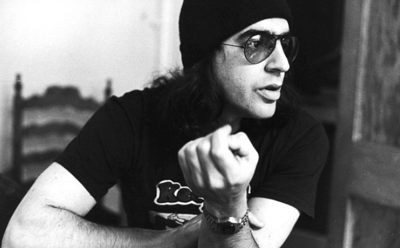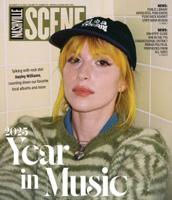When record producer-engineer Elliot Mazer died of a heart attack at his home in San Francisco on Feb. 7, at the age of 79, he left behind a rich musical legacy. That includes important contributions in the ’60s and ’70s to Nashville’s evolution as a recording center. Most notably, Mazer helped develop the genre-busting session supergroup Area Code 615, launched Linda Ronstadt’s hit-making career, produced Neil Young’s most commercially successful album, and helped establish Quadrafonic Sound Studio as ground zero for the growing number of rock and folk sessions in the city in the 1970s.
Mazer first came to Nashville in 1966 with Latin recording stars Trio Los Panchos for sessions at Columbia’s Studio B. He was just an observer on those dates as a representative of their publisher. But he did make an opportune suggestion to the group during the sessions, that they cover the Beatles’ “Girl,” and the result was the international hit “Muchacha.” Those sessions made a lasting impression on the producer.
“I fell in love with the studios in Nashville,” Mazer told me in a 2015 interview. “There was a place for the drums, there was a place for the guitar. Whereas the New York studios were big, ambient rooms, and you had to set up gobos and baffles, and there was tons of leakage.”
Mazer’s next visit to Music City was in February 1968, and again he was just an observer, this time during sessions at RCA Studio B for Canadian duo Ian & Sylvia. He had been tapped by their manager, Albert Grossman, to produce their next record and was on hand to get a better feel for their music. “Dylan had already done some stuff in Nashville, and Albert said, ‘If you want to take those kids to Nashville, go.’ I said, ‘Yeah, great.’ ”
At those February sessions, Mazer met two young musicians who would figure prominently in his future work in the city: drummer Kenneth Buttrey and bassist Norbert Putnam. When Mazer returned in June to produce sides at Bradley’s Barn for Ian & Sylvia’s album Full Circle, he made Buttrey the session leader and asked him to book Putnam and some of the other younger studio players for the dates. Guitarist Mac Gayden, steel guitarist Weldon Myrick and fiddler Buddy Spicher were among the future members of Area Code 615 who got the call.
“I was enthralled with Nashville,” Mazer said. “It was completely thrilling — great musicians and great studios, and you come out with tapes that are wonderful. As a producer, what else could you ask for? Every artist I worked with came out of Nashville with a unique, different-sounding record with wonderful stuff on it.”
The musicians he worked with appreciated Mazer, as well. “Elliot understood that the musicians here had good instincts, and if you close your mind to it, you’re probably missing a lot,” says Charlie McCoy, another member of Area Code 615 who worked on multiple records with Mazer.
Over the next few years, the New York native worked on a slew of recordings in Nashville, including albums by Gordon Lightfoot, Jerry Jeff Walker, Jake Holmes and Andy Fairweather Low. Two of the most significant records he produced in that time were the Area Code 615 albums, which were essentially the result of a lark.
During downtime at a Michael Nesmith session in 1968, Buttrey, Putnam, keyboardist David Briggs, guitarist Wayne Moss, multi-instrumentalist Bobby Thompson and a few others jammed on the Beatles’ “Lady Madonna,” combining rock and country instrumentation in a way that caught their collective ear. That led to a session at Moss’ Cinderella Sound Studio and further jamming and experimentation. When Buttrey played Mazer the results, he thought he could get the group a record deal, and he did with Polydor Records.
The group’s eponymous debut for Polydor received critical acclaim and a Grammy nomination in 1969 for Best Contemporary Instrumental Recording. The label ran full-page ads touting the record that featured the name of every band member and the producer. Their second album for the label, A Trip in the Country, earned them a four-night engagement at the Fillmore West in February of 1970 opening for Country Joe and the Fish and an appearance on The Johnny Cash Show. The group’s success significantly raised the profiles of Mazer and the musicians.
Early in 1970, Mazer brought Linda Ronstadt to Nashville and recorded the album Silk Purse at Cinderella and Woodland Studios. Those sessions yielded her first of many Top 40 hits, “Long, Long Time,” which reached number 25 on the Billboard Hot 100.
Around the time Mazer was putting a wrap on the Ronstadt album, he learned that Briggs and Putnam were opening a studio of their own, Quadrafonic Sound. As it would turn out, they gave him 10 percent of the ownership in exchange for bringing business to the studio.
“He came over just to see what we were doing, and he really loved it right from the get-go,” Briggs recalls. “And he gave us a lot of business. Even before we were officially open, he mixed some of Linda Ronstadt’s record there.”
After a couple of years, Mazer sold his interest in Quad back to Briggs and Putnam, but not before he produced the album that would come to define his career, Neil Young’s Harvest. It was the best-selling record of 1972 and yielded the No. 1 hit “Heart of Gold.” Mazer also was at the helm on sessions in 1974 for Young’s album Homegrown, which went unreleased until just last year. He continued to work with Young off and on into the ’80s, including work on the album Old Ways at House of David, the studio Briggs opened after he and Putnam sold Quadrafonic.
“A master in the studio, Elliot was a really good guy,” Young wrote on his website after receiving word of Mazer’s passing. “He had a great way about him and I wish we had gotten to do more together. I am happy and thankful though that we got what we did get. Harvest is one of my most recognized recordings, and it all happened because of Elliot Mazer.”
Mazer’s family has requested that donations in his memory be made to MusiCares.





